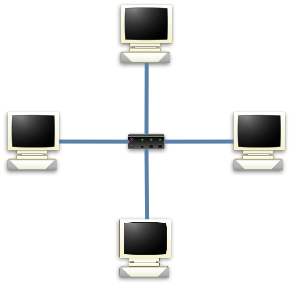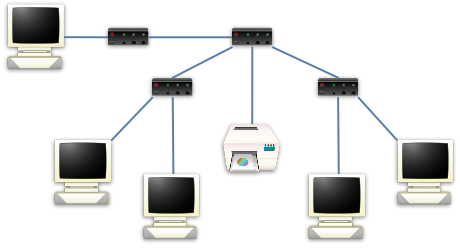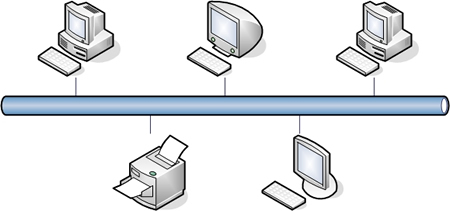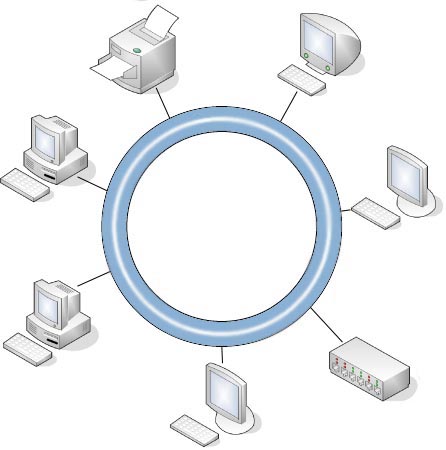Network Topology
Area Networks
LAN
A Local Area Network (LAN) is a geographically small network consisting of nodes, computers, or other devices. All of the connected devices are usually found within the same building or structure. LANs are used to segregate and organize large networks into smaller, more manageable pieces. These networks tend to be owned and operated by the same people who own the nodes that connect to the network. These networks were established for home-users whenever connecting 2 or more networked devices in their “Home Network”. The devices in a specific LAN are connected via a switch.
WAN
A Wide Area Network (WAN) is geographically larger than a LAN. WANs are usually owned and/or maintained by a larger company, which may use the WAN for corporate purposes or lease it out for communication. Telecommunication companies such as Charter Spectrum (formerly Time Warner Cable) and AT&T Inc. (formerly BellSouth) run WANs that provide a method for people and companies to join to other LANs and connect to global communications such as the Internet. LANs are connected to WANs, and WANs are connected to each other, using routers.
VLAN
NC State puts all networks into virtual LANs (VLANs), which allow nodes to be attached virtually to a LAN, instead of physically. In essence, a VLAN acts as a WAN, but at the local level.
MAN
A Metropolitan Area Network (MAN) is between a LAN and a WAN in size. It is normally owned by an Internet Service Provider (ISP), the same companies who own and operate WANs, but has a lot of features like a LAN. Companies can use a MAN across a city to connect several offices. MANs are connected using a combination of routers and specialized switches.
Configurations
Star Network
A star network is a network in which computers are connected by one central device known as a concentrator. The concentrator manages and controls all functions of the network. In addition, the concentrator acts as a repeater for the network. A repeater is a device that strengthens the signal of the communication as it travels over the appropriate medium.

Figure 1: Star network
Disconnecting a particular node in a star network will not disrupt service on the rest of the network, and the concentrator can easily locate a malfunctioning network node. If the concentrator fails, the entire network will be disabled. Some examples of star network include Ethernet switches and hubs.
Tree Network
Tree networks are collections of star networks arranged in a hierarchy. Concentrators from each star network are connected to each other in a particular order to form the tree.

Figure 2: Tree network
Like a star network, a point of failure on a transmission line can separate a node from the network and the rest of the network will continue to work. If a concentrator gets disconnected, all connected nodes are separated from the more massive tree network. If the separated connector is still functioning, the nodes in that network will also continue to function, even when separated from the tree.
Bus Network
In a bus network, a set of clients is connected using a single shared connection line known as a bus. Bus networks are the simplest way to connect devices, but problems occur when two devices want to communicate at the same time. Bus networks typically use a collision detection/prevention method known as Carrier Sense Multiple Access (CSMA) to ensure proper data communication.

Figure 3: Bus network
The only equipment that is needed to add a device to a bus network is an interface card for each node and one communication line to establish the network. A bus network is well suited for quick, temporary network setups. If one node fails along the bus, it does not bring down the entire network. However, if a line break occurs on the network, the entire network will go down. Bus network lines have a limited physical distance and a limited number of allowed nodes before system usability decreases significantly.
Ring Network
In a ring network, nodes are connected in a circular configuration. Data can travel either clockwise or counterclockwise around the ring, but all data must travel in the same direction. For information to be sent from one node to another, it must be sent around the ring and through each node until it reaches its destination.

Figure 4: Ring network
Since all nodes have equal access to the network, there is a minimal impact on the performance of the network as devices are added. However, if one device fails on the network, it is likely that other nodes will also fail, or the network may stop working entirely.